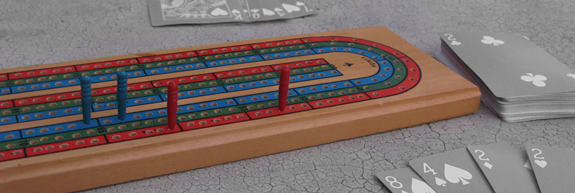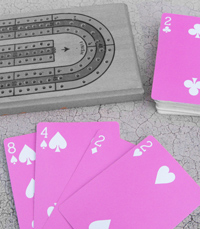 I was playing cribbage with Husband when I found my hand to be 8, 4, 2, 2 and the cut card was also a 2. I foucused hard to see if I could come up with 15. (If any group of cards add to 15, you get two points.)
I was playing cribbage with Husband when I found my hand to be 8, 4, 2, 2 and the cut card was also a 2. I foucused hard to see if I could come up with 15. (If any group of cards add to 15, you get two points.)
My resolve was strong. Then I remembered that for any group of numbers to add up to an odd number, one of them must be odd.
While shuffling for the next hand, I started thinking about adding evens and odds:
- Even + Even = Even
- Odd + Odd = Even
- Odd + Even = Odd
This looked familiar. Then I remembered the rules of multiplying positives and negatives:
- Pos x Pos = Pos
- Neg x Neg = Pos
- Neg x Pos = Neg
I was so excited to notice this. Alas, I’m pretty sure I’ve noticed it before. I love rediscovering patterns as much as discovering them!
Look for patterns everywhere.
Always keep your eyes peeled for similarities. When you see them, if your children are old enough, use leading questions to get them to observe the same thing. If they aren’t old enough, keep a journal to share things with them later.
Encourage your kids to look for patterns in everything. Use toys and manipulatives to improve this, but also use nature and everyday activities.
What patterns or nifty things in math have you noticed recently?
Related articles
- Teaching Subtraction Using a Balance
- Is Zero Positive or Negative?
- How to Improve Math Mental Math Skills
- Multiplication Tricks Roundup

This post may contain affiliate links. When you use them, you support us so we can continue to provide free content!








That’s it — you just noted the similarity of the two patterns and let it go at that? Have you looked a bit deeper at the phenomenon? The two patterns are actually related to a single, more general concept.
This would make a terrific investigation for kids at some level of development. I’m not sure exactly which level, but I bet it’s lower than you’d suspect to still get an interesting and enlightening experience.
Actually, David, I don’t know what the underlying concept is. I actually didn’t even think there was one. Which is amazingly narrow minded for me. I guess sometimes I just take things as they are and let them be. I’ll think about it now that you’ve written it. (I prefer to think on it before I google it.) Thanks for prodding me to go further!
I’m in favor of earlier is better – and it sounds like you are too. I rarely consider a concept too advanced for an age. Doing certain problems can be too advanced simply because of attention spans, vocabulary or stamina. But concepts are almost always perfect for kids who are x years old!
Well, there you did it. You got my paper and pencil out.
The “natural” extension of ‘POS x NEG = NEG‘ is NOPE. What is NOPE? It is ‘ODD number of NEG factors = NEG; EVEN number of NEG factors = POS’. (Try it.)
So, along the same line, is ‘ODD number of ODD addends = ODD; EVEN number of ODD addends = EVEN‘ true in all cases?
Should we call that OOEE?
Wow, dude.
Curious.
I’m going to have to ponder that one more.
(I got your paper and pencil out. You’re clearly gettin’ my brain going in a different direction!)